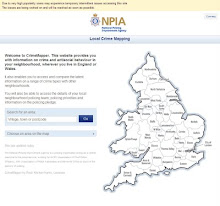Following on from our previous post and our report on police response numbers we were pleased to see Her Majesties Inspector of Constabulary launch their new "MYPOLICE" website this week at http://www.hmic.gov.uk/mypolice/pages/home.aspx
We have explored the new HMIC site in some detail over the days since its launch. There is a considerable amount of useful detail presented on the site and we shall be referred to it in future posts. First signs though, are that the HMIC have deliivered an excellent new public information resource on policing in England & Wales.
Trawling the site for information in support of our poolice response article, two reports released this week by the HMIC that are of particular interest are :-
The All Force Police Report Card and the Area Comparison on crime rates.
You can see at a glance how each force is performing overall in key areas of policing in the Police Report Card overview, and see the detailed performance information including forces’ prospects of improvement underlying this in the Police Report Card summary.
The Report card compares police force performance in four key areas:-
- Local Crime and policing
- Protecting the public from serious harm
- Delivering confidence and satisfaction
- Value for money
- Reducing crime
- Solving Crime
- Visible presence in the neighbourhood
- Neighbourhood policing
- Investigating major crime
- Suppressing gun crime
- Suppressing knife crime
- Solving serious sexual offences
- Reducing road death and injury
- Public confidence : all agencies
- Service delivery
- Satisfactiuon of BME community
- Public confidence : police
- Meeting the Pledge standards
- Perceptions of ASB
- Number of police officers and PCSO's
- Total cost of policing
- Cost per household
- Proportion of policing cost met from council tax
It will be an uncomfortable read for some. Their website press release claims that they aim to be fair in their performance assessments, and that when they compare forces, it is against a set of ‘peers’ – similar forces – taking into account budgets, crime profiles, populations and challenges. Performance grades are based on comparing like with like.
The National Overview by Denis O’Connor Her Majesties Chief Iinspector of Constubulary can be read here.
COMPARING THE FREEDOM OF INFORMATION REPLIES WITH THE HMIC REPORTS
We have taken ur previous findings from the FOI force replies and inserted the relevant HMIC data and measurement gradings alongside each force. The results make for interesting reading.
The diagram below can be clicked to view larger or downloaded directly as a pdf by clicking here
We were particularly pleased to see that the HMIC arrived at similar results to our analysis regarding response numbers.
- HMIC found that 42.5% of the police resource in Eglangland and Wales is committed to "Frontline" activity.
- Our analysis had put the "Response" percentage at a maximimum of 42%.
From our report on police response numbers the percentage was in fact nearer to 25-30% of the full time equivalent numbers of each force. The report above is sorted in order of the resource committed to purely response duties, with the worst force first in ascending order. It should be remembered that even those forces apparently committing higher numbers to response are subject to revision as those marked with a black arrow contain what we believe to be an overstated response figure.
It is interesting to compare the HMIC figures with the force FOI return percentages. Again it should be born in mind that the HMIC numbers will be based on numbers collated from forces as at 31/3/2009, whereas our FOI dta was collected between January and March 2010.
Part of the HMIC report card measurement process includes a grading for "Visible Police Presence". Again, we thought this weas a useful indicator to view alongside the response numbers. There are many forces graded as good or fair in this area by the HMIC, when there is clearly a low commitment to response policing.
CONCLUDING COMMENTS
Our findings from the FOI research, supported by this weeks release of data from the HMIC, confirm the frontline police blogs that have long since expressed concern about the lack of resources allocated to frontline policing as opposed to administrative, operational and organisational support numbers.
See for yourself the disparities between the FOI findings and the HMIC performance results.
The new information source from the HMIC site will prove helpful in compiling future analysis to determine whether forces actually deliver true value for money in this area. Frontline officers suspect that the allocation of resources to non response activity is grossly disproportionate, meaning that the vast majority of the tax payers contribution to policing pays for office based non response officers and police staff.
The conseqence of misaallocated resources is that frontline policing is exposed to a massive extra burden that is largely unseen. Senior officers and Home Office strategies manipulate crime statistics and detection rates to project the illusion of improved performance.The general public are cheated out of the full delivery of a police service that their taxes entitle them to. Instead, all the signs are, that for many years, billions in taxes have been funding teams of administrators and auditors rather than adequate provision for frontline services that would go a long way toward solving many of the problems facing our communities.
We will look more closely at the other sections of the HMIC force reports in future posts and analysis.

















